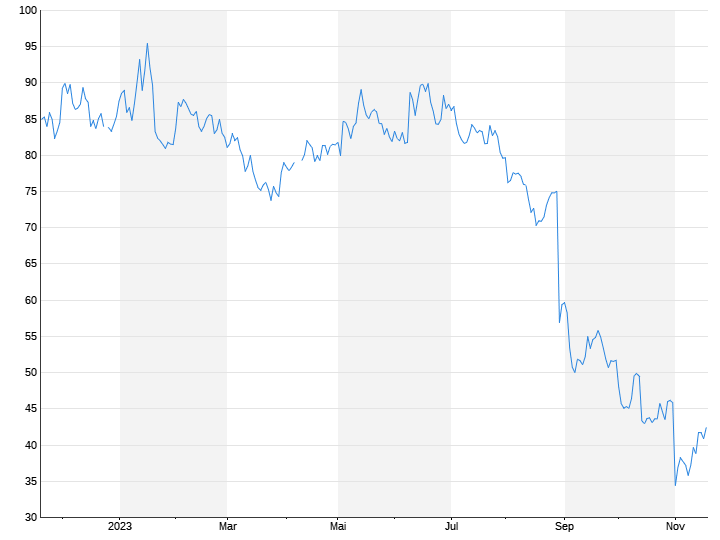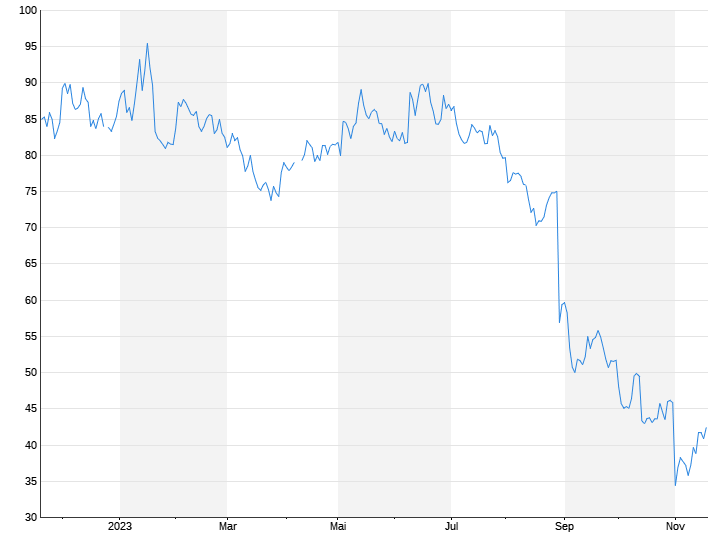Crash landing despite boom
The perfect storm kills solar and wind power
By Diana Dittmer
November 19, 2023, 7:20 a.m
Actually, wind power and solar companies can’t complain. Since the Russian attack on Ukraine, politicians have been accelerating the energy transition and business is booming. But the key industries, of all things, are in a deep crisis. Siemens Energy is just the latest example.
Anyone who expected that the energy crisis would bring wind power and solar companies a special boom and rising prices on the stock market was seriously mistaken. The traffic light government massively accelerated the expansion of renewable energies after the Russian attack on Ukraine. Companies are experiencing an unprecedented boom and their order books are full to the brim. Still, they struggle to make money. The increased demand turns out to be a shot in the back: new projects are expensive, The debts are overwhelming and the company’s shares are proving to be a brake on many portfolios this year.
“The development of shares in the solar and wind sectors is devastating,” summarizes ntv stock market reporter Frank Meyer. SolarEdge and Enphase Energy from the solar sector have each lost around 70 percent since the beginning of the year. The Danish wind farm giant Orsted lost over 50 percent, Vestas Wind Systems almost 14 percent. The securities in the industry are usually far away from their all-time highs. The corresponding index funds – which bundle securities thematically in order to minimize the risks of individual companies – are also experiencing a drought. The S&P Global Clean Energy ETF and the iShares Global Clean Energy ETF, for example, have fallen more than 30 percent since January.

The core problem is high interest rates and volatile costs. Companies cannot pass everything on to customers. Supply chain problems, but also overcapacity and a ruinous price war are doing the rest. SolarEdge slipped into the red in the third quarter because sales plummeted. For the wind farm operator Orsted, two failed offshore projects in the USA resulted in almost four billion euros in depreciation and a loss of 2.7 billion euros. The world’s largest turbine manufacturer Vestas surprised at the beginning of the month with black figures for the third quarter. But competition for higher prices is fierce. Turbines require major investments, not only in development but also for the plants. Until an order is completed, companies make financial advance payments for years.
High costs, high interest rates, excess capacity
The result is crash landings, of all things in a boom phase. In the difficult situation, quality deficiencies at the Spanish subsidiary Gamesa ultimately proved fatal to Siemens Energy. A 7.5 billion euro guarantee from the federal government and a complicated rescue concept are keeping the company afloat for the time being, but the cocktail of problems remains: The wind situation is “very serious,” said Joe Kaeser, chairman of the supervisory board of Siemens Energy, in a recent interview with “Welt am Sonntag”. The entire industry is making horrendous losses. It is a young industry that has not yet been consolidated.
“Capital costs have risen everywhere due to the rapid change in interest rates,” says Meyer. “Long approval processes make the projects uncertain in terms of timing and make them even more expensive.” The price war in the solar and wind sector is brutal: orders are being relocated to China for cost reasons. At the same time, Beijing is pushing ahead with the expansion of renewable energies, and companies outside the industry also want a piece of the green cake and are flooding the global market with cheap solar components. There is also a “rat race” in the wind power industry, as one manager described the misery a year ago. A note in the half-year report from Longi Green Energy Technology, one of the largest Chinese solar companies, from August does not bode well: “The entire industry is about to enter the knockout round,” quotes the Wall Steet Journal.
There is a threat of a bang after years in which one crisis has followed the next: “At the time when the wave of inflation began, these companies were hit very hard by both steel and semiconductor inflation,” the business portal Business Insider quotes Martin Frandsen, portfolio manager at Principal Asset Management. “Right when you start to catch up and can breathe a sigh of relief again, interest rate increases come along.” This is what we call a perfect storm.
“Zero interest rates are crucial”
In order for the situation to ease, the interest rate turnaround is essential, says ntv stock market expert Meyer. “These business models can only survive with zero interest rates because of their low margins,” he warns. This also applies to the hydrogen industry.
So will Siemens Energy follow suit? Does the state have to help the industry with large energy projects if political goals are to be achieved? NordLB boss Jörg Frischholz thinks yes. “It is necessary for the state to support large projects, strong capacity expansion and larger individual projects,” he told “Capital”. But it’s not about cash, but about additional protection or default guarantees.
“The scope of what we have set out to do together as an economy is about cleverly interlinking all the building blocks,” he explains – and predicts: If there is no help, many potential investors in this area will shy away from the risks. Philipp Godron from the think tank and lobby organization Agora Energiewende, on the other hand, demands that the stumbling wind power industry face competition, as he says in the “Capital” interview. “If problems arise at individual companies, that’s not good for competition and expansion. But that doesn’t mean that there isn’t a market of manufacturers who can meet the growing demand. The competition closes the supply gap.”
This offers little guidance for investors who want to invest in the renewable energy sector. “There were good and bad years,” says financial advisor Annika Peters in an interview with ntv. “2019 and 2020 were good, we saw a very strong performance in the industry and on the stock market. But in the last three years companies have struggled.” But every trend topic is a risk. That’s why it should only ever be an admixture.
